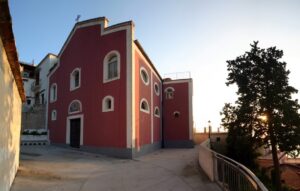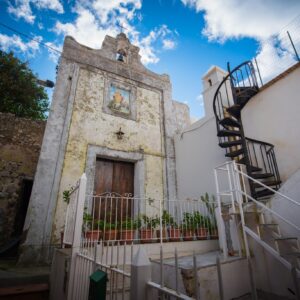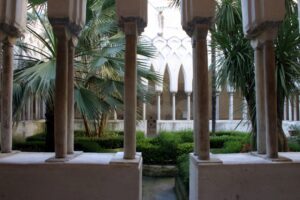MUNICIPALITY: Ravello
NAME: Sanctuary of Saints Cosma and Damiano
LOCATION: Piazza S. Cosma
DESCRIPTION: The church that can be seen now comes from the enlargement of the old structure, begun in the 1950s and not completed until 1970. The old church was a small rectangular structure set into the rock with a barrel vault roof and a miniature bell tower on the mountain; the new building consists of a large rectangular hall with a grandiose barrel vault and central apse.
The façade is in the form of a round arch, slightly lowered, while a mosaic in the apse basin reproduces the two saints venerated in the church and the four tortures to which they were subjected, painted by the painter Liotti and the masters of Pietrasanta from Lucca.
SEE, VISIT, FIND: The church is open during liturgical celebrations or by turning to the nearby parish house.
FRUITION DATA: During the month following the celebration of the saints (Sept. 26) the church is the destination of numerous pilgrimages.
OPPORTUNITIES: There is a lack of information supports on the historical and architectural features of the structure (information on the modern construction could be supplemented with information on the previous church).
BIBLIOGRAPHY: FULCHIGNONI G., Ravello. Ravello. Le cento chiese, Amalfi 2001
IMPERATO G., Ravello nella storia civile e religiosa, Cava d. T. 1990
MANSI L., Ravello sacra-monumentale, Ravello 1887
SANTUARIO SANTI COSMA E DAMIANO
“The Miraculous Fontanelle and the Sacrificial Church”
The shrine dedicated to Saints Cosmas and Damian appears embedded in the cliff above it and is surrounded by a large terrace offering a wonderful view of the Amalfi Coast. It is a pilgrimage destination for devotees from the entire region who arrive there even after days of walking. The new shrine with the panoramic terrace was built between 1950 and 1970 in order to have adequate space to accommodate a large number of pilgrims, demolishing the old church that stood near a small spring, believed to be miraculous. The new construction consists of a large rectangular hall with a barrel vault and central apse.
Salvatore Amato, L’antico Santuario di San Cosma ‘aggrappato’ allo sperone del Cimbrone – “Il Vescovado – www.ilvescovado.it
The shrine of Saints Cosma and Damiano, as it can be seen today, is very different from what it looked like before the 1960s. The earliest document mentioning the ancient church dates from 1397 and is preserved in the metropolitan curia of Amalfi; it is a letter sent by Pope Boniface IX to the bishop of Tropea Paolo de Grifiis on September 14. It ordered the bishop to entrust to the Sipontine cleric Antonio de Fusco the parish church of Santa Maria a Gradillo and of Saints Cosmas and Damian of Ravello. In the Episcopal Archives of Ravello the earliest document to have come down is dated May 17, 1402, written in pre-humanistic Gothic. It tells us that Martino Scatozza, vicar of the bishop of Ravello Ludovico Appenditano, took possession of some property left by the will of Francesco Vessichello, including an olive grove located in the appurtenances of Ravello in the locality A la porta Dopnica (Domnica) and sold it to the church of Saints Cosma and Damiano. The same Martino Scatozza who later became rector of the Church of Saints Cosmas and Damian buys in excambium in 1426 some properties including a piece of olive grove located in Ravello and whose boundaries are defined. To the benefit of the ancient church is then added in 1484 a hospice of houses located in the locality De La Terra, as a result of the sale that Amata Lusta and her sons Nicola Tolentino and Luigi make to Giacomo di Giovanni Frezza, rector of the church of Saints Cosma e Damiano. In the 1577 pastoral visitation of Msgr. Paolo Fusco, the church is not mentioned perhaps because of the lack of sheet(s) in his liber visitationis.
We know, however, of a chapel dedicated to the Medical Saints under the patronage of the De Furno family, at the time “desolate and ruined” and located in the church of St. Matteo del Pendolo. Between 1610 and 1612 during the pastoral visits called by Msgr. Francesco Bennio, the archbishop ordered that the marble blessed water pile, which had stood outside the church since 1604, be moved inside and asserted that the faithful had a special devotion to Saints Cosmas and Damian. In the second pastoral visitation made by Bishop Bernardino Panicola in 1665 by his vicar-general Antonio de Panicolis we find the church of Saints Cosmas and Damian as a simple benefice of the church of Beata Maria de Lago along with the churches of St. Matthew and St. Andrew de Pendulo.
From this pastoral visitation, we also know that the church contains a gilded statue of St. Cosmas with a relic. By order of the bishop, however, the statue is kept in the Holy Trinity monastery and is transported to St. Cosmas only on the festive day. In 1710 during the visit of Bishop Giuseppe Maria Perimezzi the church of St. Cosmas is officiated although united with that of St. Matteo del Pendolo. In the church, he found there 23 silver ex-voti, donated by the faithful “ex devotione pro gratis ab ipsis recepitis,” and ordered that the statue of St. Cosmas, existing in the church of the Holy Trinity monastery, be transferred there with two bells, one from the cathedral clock and the other from the said monastery. The statue was restored in 1756. In the nineteenth century a detailed description of the small church, called by the Camera cappella di San Cosmo, is offered by Luigi Mansi. He tells us that the church has a single nave covered by a barrel vault in which are two altars: one dedicated to Saints Cosma and Damiano and the other to St. Onofrio, an oriental hermit saint which makes more insistent the currently unprovable hypothesis of an original anchorite-type settlement.
Continuing the description we know of many ex-voti placed on the cornice and the presence of a sacristy and two small rooms without furnishings. In 1898 the Confalone family redid the floor of the church and gave evidence of this by placing a marble plaque at the entrance. The entrance to the small church was provided by a long ramp of stairs. On a landing of this ramp was an archway with frescoes depicting the two saints in a rigid frontal, two-dimensional pose of Byzantine tradition, dating in all likelihood from well before the 14th – 15th century, that is, when we begin to have news of the church. From the sacristy, a voice was given through a rope to the two bells placed on a small bell tower inserted in the rock. A ruin of it that can still be seen today high up on the cliff is the last trace of the past. On September 26, 1965, Archbishop Angelo Rossini blessed the new shrine amidst a jubilant and moved crowd.





